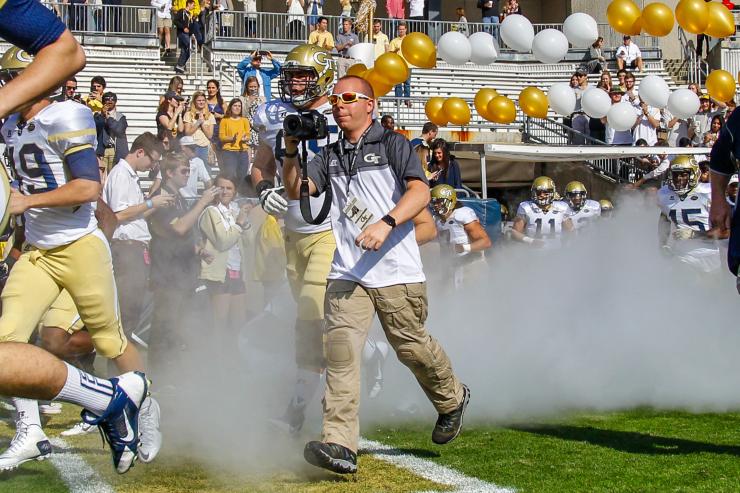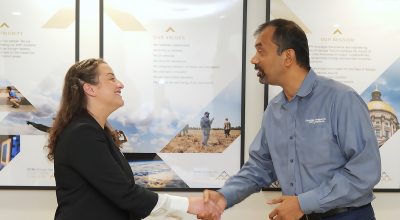
Alumnus Danny Karnik gets to exercise the left and right sides of his brain on an almost daily basis. As a research engineer in the Georgia Tech Research Institute, he flexes his engineering muscles. Outside of office hours, Karnik captures the action on the field and court as Georgia Tech’s official sports photographer. Read our interview with him to learn about his “day job” doing applied research for Electronic Warfare (EW) systems for the Department of Defense, how his love of gadgets led him to photography, and what it was like being in the end zone during the “Miracle on Techwood Drive.”
Name: Danny Karnik
GT Degree(s): BSEE, 2007 | MSECE, 2016
Current Title/Position: Research Engineer
Current Company/Organization: Georgia Tech Research Institute (GTRI)
What are your day-to-day duties at GTRI?
I do applied research and development for Electronic Warfare (EW) systems for the Department of Defense (DoD). My current title is Research Engineer I, but I recently received the notice from President Peterson that in July I will be promoted to Research Engineer II. The day-to-day job duties vary wildly. One day I might be working on designing a circuit card, testing a piece of hardware the next, writing a report another day, or travelling to the test range or military base in support of a field test. The projects vary depending on current contracts, but often it is in support of a system that protects our troops overseas, and I take great pride in knowing that I’m helping them to make it back home.
How did you end up working for GTRI? Was it your first job after graduating?
After my first semester at Tech, I decided I should look into the co-op program, and began applying for jobs in my 2nd semester. I didn’t know much about GTRI, but they were one of the available positions for my major. After my initial interview which gave me an overview of GTRI, I had a follow up interview with the Electronic Systems Laboratory (ELSYS) and was offered a co-op position. I co-opted with them for six full semesters, and worked part-time the other semesters in between classes. As graduation drew near, I interviewed with GTRI and with Lockheed Martin, but made the right choice to stay with GTRI.
Why did you decide to study electrical engineering?
I’ve always been interested in electronic gadgets, and growing up would often take apart old VCRs or stereo equipment to look at the circuit boards, so it seemed like a natural fit.
Who was your favorite professor in ECE?
My favorite professor was Dr. Tom Gaylord. Dr. Gaylord taught me so much about optics and is a great professor. He also has a great sense of humor that I really enjoyed.
What advice would you give current ECE students?
Talk to alumni, professors, staff, and other students to find out about all the different fields available in ECE. Knowing what’s out there will help you pick classes that you are truly interested in, which will make it so much easier to learn. Also, do your homework. Coming out of high school, many of us didn’t have to do homework or study because everything was such a breeze. Georgia Tech is not like that, and it’s better to stay ahead of the curve and do your homework and study before you find out the hard way that it’s something you really need to do.
How did you get into photography? Is it a hobby or a side job?
My dad had a Pentax film SLR that we would take to airshows, and I really enjoyed taking photos with that. I decided when the technology progressed enough, I’d get a DSLR. In 2007, an engineer at GTRI brought in her Nikon D80 and showed it to me, and I knew that the time had come. I ordered mine online the next day and began taking pictures of whatever I could. In the 10 years since then, I’ve probably taken over a million photos, and have upgraded my equipment numerous times to take advantage of technological advances and to get better optical performance. My photography began as a hobby, but now is a side job. In reality, it’s probably a second full-time job with the amount of time I dedicate to it.
How did you start taking photos for Georgia Tech sporting events?
The first year I had my camera, I got to a GT football game early to get in the front row. It was Georgia Tech’s game against Samford, and there was a lot of offense to be seen (the Jackets won 69-14). I had such a blast that I took my camera to the rest of the games that season. One of our linebackers at the time, Gary Guyton, was working in Research Security at GTRI, and had seen my photos. He mentioned that I should talk to Sports Information at the Athletic Association to try and take photos for the Jackets. I went over and spoke with them, but was turned down. During the 2008 season, I would buy a regular ticket and then sneak into the student section as an alumni to make sure I could still take photos. In 2009, I was able to buy season tickets in the front row of the end zone and continued shooting from there. As I was renewing the tickets the following season, I was speaking with a former offensive lineman, A.J. Smith, and he mentioned again that I should talk to Sports Information. With an expanded portfolio and a name of someone to speak to, I started exchanging emails about the possibility of shooting for GT. I was able to shoot a spring football practice, and then the spring game, but was told that the sidelines were too busy for the 2010 season. I was given a pass for the game against Middle Tennessee State on October 16th, 2010, and was also told I could photograph Georgia Tech Volleyball if I wanted to. I began shooting volleyball, which I discovered was really entertaining. When I got onto the sidelines for the GT vs. MTSU game, it was one of the greatest days of my life. The experience was so wonderful that I hoped I could do it again. Luckily, GT was pleased with my photos, and offered me passes to the rest of the games that season. After that, I began shooting all the other sports for them, and in 2012, they made me their official photographer.
What’s the best part of taking photos for Georgia Tech?
The best part is really the relationships. Being able to work so closely with our student-athletes, coaches, and staff members has given me a number of friendships with great people that I wouldn’t have had otherwise. Of course, it’s also really cool to be present for great moments in Georgia Tech sports history, and to be responsible for capturing those moments forever. Sometimes I even get really involved in those moments, like during the Florida State game in 2015 (the Miracle on Techwood Drive), when Lance Austin returned the blocked kick for the game winning score and literally ran it right to me in the end zone. I was crushed against the wall by Lance and the rest of the team in the celebration, but what a memory to have for the rest of my life.



